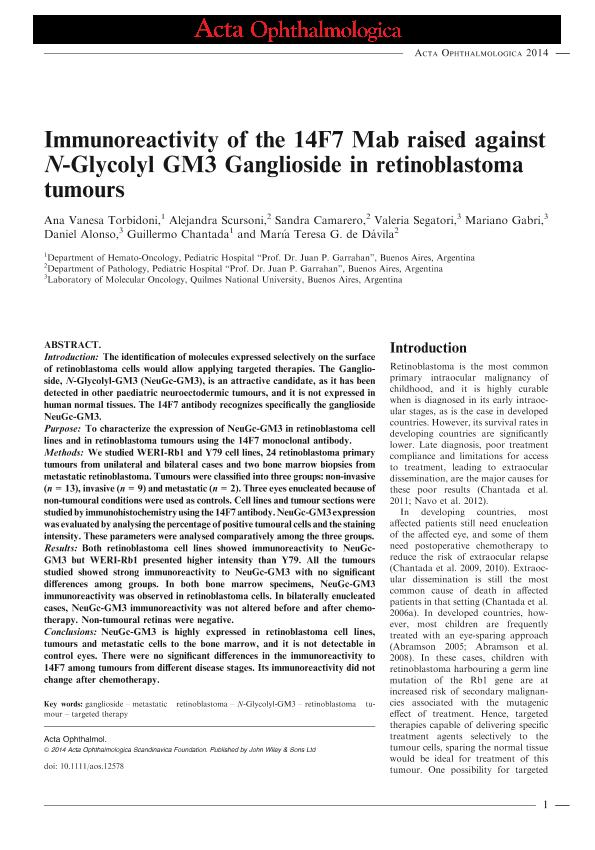Artículo
Immunoreactivity of the 14F7 Mab raised against N-Glycolyl GM3 Ganglioside in retinoblastoma tumors
Torbidoni, Ana Vanesa ; Scursoni, Alejandra; Camarero, Sandra; Segatori, Valeria Inés
; Scursoni, Alejandra; Camarero, Sandra; Segatori, Valeria Inés ; Gabri, Mariano Rolando
; Gabri, Mariano Rolando ; Alonso, Daniel Fernando
; Alonso, Daniel Fernando ; Chantada, Guillermo Luis
; Chantada, Guillermo Luis ; de Dávila, Maria Teresa
; de Dávila, Maria Teresa
 ; Scursoni, Alejandra; Camarero, Sandra; Segatori, Valeria Inés
; Scursoni, Alejandra; Camarero, Sandra; Segatori, Valeria Inés ; Gabri, Mariano Rolando
; Gabri, Mariano Rolando ; Alonso, Daniel Fernando
; Alonso, Daniel Fernando ; Chantada, Guillermo Luis
; Chantada, Guillermo Luis ; de Dávila, Maria Teresa
; de Dávila, Maria Teresa
Fecha de publicación:
09/2014
Editorial:
Wiley Blackwell Publishing, Inc
Revista:
Acta Ophthalmologica
ISSN:
1755-375X
Idioma:
Inglés
Tipo de recurso:
Artículo publicado
Clasificación temática:
Resumen
Introduction The identification of molecules expressed selectively on the surface of retinoblastoma cells would allow applying targeted therapies. The Ganglioside, N-Glycolyl-GM3 (NeuGc-GM3), is an attractive candidate, as it has been detected in other paediatric neuroectodermic tumours, and it is not expressed in human normal tissues. The 14F7 antibody recognizes specifically the ganglioside NeuGc-GM3. Purpose To characterize the expression of NeuGc-GM3 in retinoblastoma cell lines and in retinoblastoma tumours using the 14F7 monoclonal antibody. Methods We studied WERI-Rb1 and Y79 cell lines, 24 retinoblastoma primary tumours from unilateral and bilateral cases and two bone marrow biopsies from metastatic retinoblastoma. Tumours were classified into three groups: non-invasive (n = 13), invasive (n = 9) and metastatic (n = 2). Three eyes enucleated because of non-tumoural conditions were used as controls. Cell lines and tumour sections were studied by immunohistochemistry using the 14F7 antibody. NeuGc-GM3 expression was evaluated by analysing the percentage of positive tumoural cells and the staining intensity. These parameters were analysed comparatively among the three groups. Results Both retinoblastoma cell lines showed immunoreactivity to NeuGc-GM3 but WERI-Rb1 presented higher intensity than Y79. All the tumours studied showed strong immunoreactivity to NeuGc-GM3 with no significant differences among groups. In both bone marrow specimens, NeuGc-GM3 immunoreactivity was observed in retinoblastoma cells. In bilaterally enucleated cases, NeuGc-GM3 immunoreactivity was not altered before and after chemotherapy. Non-tumoural retinas were negative. Conclusions NeuGc-GM3 is highly expressed in retinoblastoma cell lines, tumours and metastatic cells to the bone marrow, and it is not detectable in control eyes. There were no significant differences in the immunoreactivity to 14F7 among tumours from different disease stages. Its immunoreactivity did not change after chemotherapy.
Archivos asociados
Licencia
Identificadores
Colecciones
Articulos(SEDE CENTRAL)
Articulos de SEDE CENTRAL
Articulos de SEDE CENTRAL
Citación
Torbidoni, Ana Vanesa; Scursoni, Alejandra; Camarero, Sandra; Segatori, Valeria Inés; Gabri, Mariano Rolando; et al.; Immunoreactivity of the 14F7 Mab raised against N-Glycolyl GM3 Ganglioside in retinoblastoma tumors; Wiley Blackwell Publishing, Inc; Acta Ophthalmologica; 93; 4; 9-2014; 294-300
Compartir
Altmétricas



